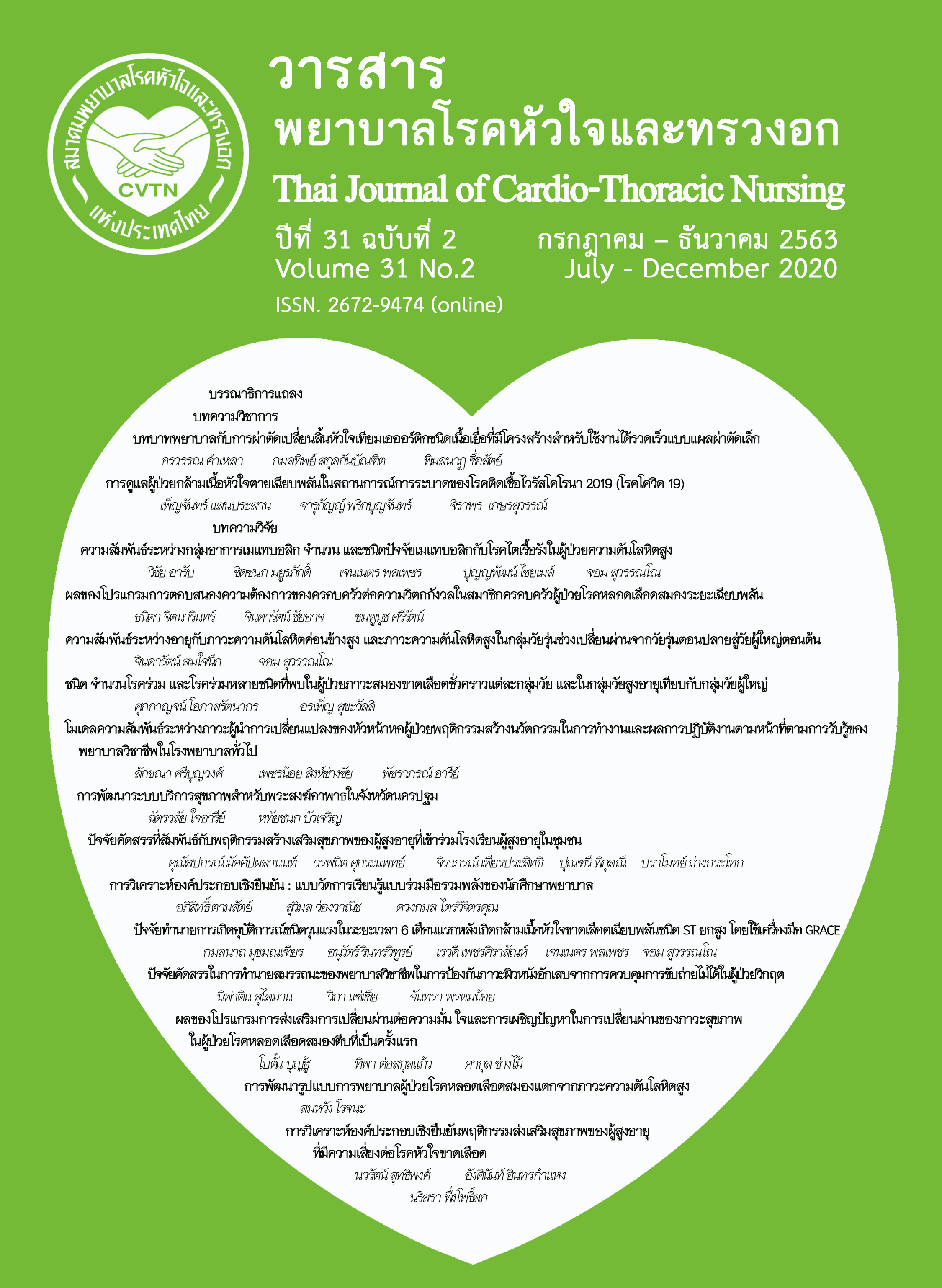การวิเคราะห์องค์ประกอบเชิงยืนยัน : แบบวัดการเรียนรู้แบบร่วมมือรวมพลัง ของนักศึกษาพยาบาล
คำสำคัญ:
แบบวัดการเรียนรู้แบบร่วมมือรวมพลัง, นักศึกษาพยาบาลบทคัดย่อ
การวิจัยนี้มีวัตถุประสงค์เพื่อวิเคราะห์องค์ประกอบเชิงยืนยันของแบบวัดการเรียนรู้แบบร่วมมือรวมพลัง ตัวอย่าง คือ นักศึกษาพยาบาล ชั้นปีที่ 2, 3 และ 4 จากวิทยาลัยพยาบาลในสังกัดกระทรวงกลาโหมและสำนักงานตำรวจแห่งชาติ ด้วยวิธีการสุ่มอย่างง่าย จำนวน 240 คน เครื่องมือวิจัยเป็นแบบสอบถามประกอบด้วยข้อมูลทั่วไป และแบบวัดการเรียนรู้แบบร่วมมือรวมพลัง วิเคราะห์ข้อมูลโดยใช้ 1) สถิติบรรยาย ได้แก่ ความถี่ ร้อยละ ค่าเฉลี่ย ส่วนเบี่ยงเบนมาตรฐาน และ 2) การวิเคราะห์องค์ประกอบเชิงยืนยัน
ผลการวิจัยพบว่า แบบวัดการเรียนรู้แบบร่วมมือรวมพลังที่นำมาวิเคราะห์องค์ประกอบ
เชิงยืนยันนี้ ผู้วิจัยพัฒนามาจากการทบทวนวรรณกรรม ประกอบด้วย 3 ด้าน 21 ตัวบ่งชี้ คือ 1) ด้านอารมณ์ ความคิด ความเชื่อในการเรียนรู้แบบร่วมมือรวมพลัง จำนวน 6 ตัวบ่งชี้ 2) ด้านความสามารถในการเรียนรู้แบบร่วมมือรวมพลัง จำนวน 6 ตัวบ่งชี้ และ 3) ด้านพฤติกรรมการเรียนรู้แบบร่วมมือรวมพลัง จำนวน 9 ตัวบ่งชี้ มีค่าสัมประสิทธิ์แอลฟาของครอนบาคของแบบวัดโดยเฉลี่ยทั้งฉบับเท่ากับ .958 และแต่ละด้านเท่ากับ .892, 892, และ .920 ตามลำดับ และมีผลการวิเคราะห์โมเดลการวัดการเรียนรู้แบบร่วมมือรวมพลังที่สอดคล้องกลมกลืนกับข้อมูลเชิงประจักษ์อย่างมีนัยสำคัญทางสถิติ (chi-square (df = 171, n = 240) = 310.486, p = .000; χ2/df=1.816; CFI = .959, TFI = .950; SRMR = .053, RMSEA = .058)
ข้อเสนอแนะ อาจารย์พยาบาลสามารถนำแบบการเรียนรู้แบบร่วมมือรวมพลังไปใช้ใน
การประเมินการเรียนรู้ของนักศึกษาพยาบาลเพื่อให้ได้ข้อมูลสารสนเทศที่นำไปสู่การพัฒนาการจัดกิจกรรม การเรียนการสอนทางการศึกษาพยาบาลให้มีความเหมาะสม
เอกสารอ้างอิง
Kunaviktikul W. Teaching and learning in the discipline of nursing in the 21st century. Nursing Journal. 2015;42(2): 152-6. (in Thai).
Breen H. Examining Harasim's online collaborative learning theory for nursing education [Dissertation]. Honolulu, Hawaii, U.S.: University of Hawai'i at Manoa; 2013.
Posey L, Pintz C. Online teaching strategies to improve collaboration among nursing students. Nurse Educ Today. 2006;26(8):680-7.
Parker B, Myrick F. A critical examination of high-fidelity human patient simulation within the context of nursing pedagogy. Nurse Educ Today. 2009;29(3):322-9.
Chaikongkiat P, Niha S, Chantarasiripoot B. 21st century learning skills of nursing students: A survey research in Yala. The Southern College Network Journal of Nursing and Public Health. 2019;6(1):112-20. (in Thai).
Janepanish-Visudtibhan P, Disorntatiwat P. Learning style preferences of nursing students at Ramathibodi School of Nursing, Faculty of Medicine, Ramathibodi Hospital, Mahidol University. Nursing Journal of the Ministry of Public Health. 2015;25(1):70-82. (in Thai).
Pitsachart N, Techasatian K, Juthamanee S, Leelakraiwan C. Nursing students' learning styles in school of nursing, Shinawatra University. Journal of the Police Nurses. 2018;10(1):173-9. (in Thai).
Nielson M, Warren L, Graham D. Promoting collaboration in undergraduate nursing students. J Nurs Educ. 2019;58(11):657-60.
Yang K, Woomer GR, Matthews JT. Collaborative learning among undergraduate students in community health nursing. Nurse Educ Pract. 2012;12(2):72-6.
Sandahl S. Collaborative testing as a learning strategy in nursing education: a review of the literature. Nurs Educ Perspect. 2009;30(3):171-5.
Olivares OJ. Collaborative critical thinking: Conceptualizing and defining a new construct from known constructs. Issues Educ. Res. 2005;15(1):86-100.
Yasmin M, Naseem F. Collaborative learning and learner autonomy: Beliefs, practices and prospects in Pakistani engineering universities. IEEE Access. 2019;7:71493-9.
Zhang J, Cui Q. Collaborative learning in higher nursing education: A systematic review. J Prof Nurs. 2018;34(5):378-88.
Souers C, Kauffman L, McManus C, Parker V. Collaborative learning: A focused partnership. Nurse Educ Pract. 2007;7(6):392-8.
Janssen J, Bodemer D. Coordinated computer-supported collaborative learning: Awareness and awareness tools. Educ Psychol. 2013;48(1):40-55.
Orvis KL, Lassiter AL. Computer-supported collaborative learning: The role of the instructor: IGI Global. 2006:158-79.
So H, Brush TA. Student perceptions of collaborative learning, social presence and satisfaction in a blended learning environment: Relationships and critical factors. Comput Educ. 2008;51(1):318-36.
Wiggs CM. Collaborative testing: Assessing teamwork and critical thinking behaviors in baccalaureate nursing students. Nurse education today. 2011;31(3):279-82.
Järvenoja H, Järvelä S. Emotion control in collaborative learning situations: Do students regulate emotions evoked by social challenges. Br J Educ Psychol. 2009;79(3):463-81.
Chatterjee R, Correia AP. Online students’ attitudes toward collaborative learning and sense of community. Am. J. Distance Educ. 2020;34(1):53-68.
Le H, Janssen J, Wubbels T. Collaborative learning practices: Teacher and student perceived obstacles to effective student collaboration. Camb J Educ. 2018;48(1):103-22.
Florence WM. A cross-sectional study: Collaborative learning approach enhances learning attitudes of undergraduate nursing students. GSTF Journal of Nursing and Health Care (JNHC). 2018;5(1).
Ignacio J, Chen HC. Cognitive integration in health professions education: Development and implementation of a collaborative learning workshop in an undergraduate nursing programme. Nurse Educ Today. 2020:104436.
Stahl G. Group cognition in computer-assisted collaborative learning. J Comput Assist Learn. 2005;21(2):79-90.
Stahl G. Theories of collaborative cognition: Foundations for CSCL and CSCW together. Computer-supported collaborative learning at the workplace Boston, MA: Springer; 2013:43-63.
Stahl G. A decade of CSCL. Intern. J. Comput.-Support. Collab. Learn. 2015;10:337–44.
Soper D. A-priori sample size calculator for structural equation models [Software]. 2020.
Hayton JC, Allen DG, Scarpello V. Factor retention decisions in exploratory factor analysis: A tutorial on parallel analysis. Organ Res Methods. 2004;7(2):191-205.
ดาวน์โหลด
เผยแพร่แล้ว
รูปแบบการอ้างอิง
ฉบับ
ประเภทบทความ
สัญญาอนุญาต
บทความนี้ยังไม่เคยตีพิมพ์หรืออยู่ในระหว่างส่งไปตีพิมพ์ในวารสารอื่น ๆ มาก่อน และกองบรรณาธิการขอสงวนสิทธิ์ในการตรวจทาน และแก้ไขต้นฉบับตามเกณฑ์ของวารสาร ในกรณีที่เรื่องของท่านได้ได้รับการตีพิมพ์ในวารสารฉบับนี้ถือว่าเป็น ลิขสิทธิ์ของวารสารพยาบาลโรคหัวใจและทรวงอก






